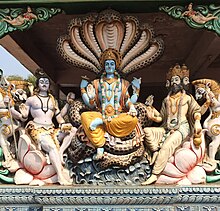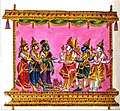Trimurti


| Part of a series on |
| Hinduism |
|---|
 |
The Trimurti[a](/t̪ɾimʊɾt̪iː/) is the trinity of supreme divinity in Hinduism,[2][3][4][5] in which the cosmic functions of creation, preservation, and destruction are personified as a triad of deities. Typically, the designations are that of Brahma the creator, Vishnu the preserver, and Shiva the destroyer.[6][b] The Om symbol of Hinduism is considered to have an allusion to Trimurti, where the A, U, and M phonemes of the word are considered to indicate creation, preservation and destruction, adding up to represent Brahman.[7] The Tridevi is the trinity of goddess consorts for the Trimurti.[8]
Evolution
The Puranic period from the 4th to the 12th century CE saw the rise of post-Vedic religion and the evolution of what R. C. Majumdar calls "synthetic Hinduism."[9]
Following is a well-known verse from the Vishnu Purana (1.2.66) that mentions Brahma, Vishnu, and Shiva together in a single verse, highlighting their roles within the cosmic functions of creation, preservation, and destruction.
rūpāṇi trīṇi tatraiva mūrttibheda-vibhāgataḥ |
ajāmyekāmśam ātmānaṁ śiva-rūpeṇa tishthati ||
jagataḥ sthiti-samdhānaṁ samharanti yuge yuge |
trayaṁ brahma-mahā-viṣṇu-māheśvara-iti smṛtam ||
Translation: "In this way, the one supreme entity divides itself into three forms—Brahma, Vishnu, and Mahesh (Shiva)—taking on different aspects. It creates, preserves, and destroys the universe in various ages."
This period had no homogeneity, and included orthodox Brahmanism in the form of remnants of older Vedic faith traditions, along with different sectarian religions, notably Shaivism, Vaishnavism, and Shaktism that were within the orthodox fold yet still formed distinct entities.[10] One of the important traits of this period is a spirit of harmony between orthodox and sectarian forms.[11]
Regarding this spirit of reconciliation, R. C. Majumdar says that:
Its most notable expression is to be found in the theological conception of the Trimūrti, in other words, the manifestation of the supreme God in three forms of Brahmā, Viṣṇu, and Śiva ... But the attempt cannot be regarded as a great success, for Brahmā never gained an ascendancy comparable to that of Śiva or Viṣṇu, and the different sects often conceived the Trimūrti as really the three manifestations of their own sectarian god, whom they regarded as Brahman or Absolute.[12]
The identification of Brahma, Vishnu, and Shiva as one being is strongly emphasized in the Kūrma Purāṇa, wherein 1.6 Brahman is worshipped as Trimurti; 1.9 especially inculcates the unity of the three gods, and 1.26 relates to the same theme.[13]
Noting Western interest in the idea of trinity, historian A. L. Basham explains the background of the Trimurti as follows:
There must be some doubt as to whether the Hindu tradition has ever recognized Brahma as the Supreme Deity in the way that Visnu and Siva have been conceived of and worshiped.[14]
The concept of Trimurti is also present in the Maitri Upanishad, where the three gods are explained as three of his supreme forms.[15]
Trimurti temples

Temples dedicated to various permutations of the Trimurti can be seen as early as the 6th century CE, and there are still some temples today in which the Trimurti are actively worshipped.[citation needed]
- Mithrananthapuram Trimurti Temple
- Prambanan Trimurti Temple
- Savadi Trimurti Temple
- Thripaya Trimurti Temple
- Shiva, Vishnu, and Brahma Adoring Kali
- Trimurti and Tridevi
- The Hindu Gods Vishnu, Shiva, and Brahma
Views within Hinduism
In general, it can be said that the Trimurti has less of a role in the Hinduism of recent centuries than in ancient India.
Shaivism

Shaivites hold that, according to Shaiva Agama, Shiva performs five actions: creation, preservation, dissolution, grace, and illusion. Respectively, these first three actions are associated with Shiva as Sadyojata (akin to Brahma), Vamadeva (akin to Vishnu) and Aghora (akin to Rudra).
Thus, Brahma, Vishnu and Rudra are not deities different from Shiva, but rather are forms of Shiva. As Brahma/Sadyojata, Shiva creates. As Vishnu/Vamadeva, Shiva preserves. As Rudra/Aghora, he dissolves. This stands in contrast to the idea that Shiva is the "God of destruction." Shiva is the supreme God and performs all actions, of which destruction is only but one. Ergo, the Trimurti is a form of Shiva Himself for Shaivas.
Shaivites believe that Shiva is the Supreme, who assumes various critical roles and assumes appropriate names and forms, and also stands transcending all these.[16] A prominent visual example of a Shaivism version of the Trimurti is the Trimurti Sadashiva sculpture in the Elephanta Caves on Gharapuri Island.
Vaishnavism

Despite the fact that the Vishnu Purana describes that Vishnu manifests as Brahma in order to create and as Rudra (Shiva) in order to destroy,[17] Vaishnavism generally does not acknowledge the Trimurti concept. Instead, they believe in the avataras of Vishnu like Narasimha, Rama, Krishna, and so forth.
They also believe that Shiva and Brahma are both forms of Vishnu. For example, the Dvaita school holds Vishnu alone to be the Supreme God, with Shiva subordinate, and interprets the Puranas differently. For example, Vijayindra Tîrtha, a Dvaita scholar interprets the 18 puranas differently. He interprets the Vaishnavite puranas as satvic and Shaivite puranas as tamasic and that only satvic puranas are considered to be authoritative.[18]
The tradition of Sri Vaishnavism in the south holds that all major deities that are hailed in the Puranas are in fact forms of Vishnu, and that the scriptures are dedicated to him alone.[19]
Shaktism
The female-centric Shaktidharma denomination assigns the eminent roles of the three forms (Trimurti) of Supreme Divinity not to masculine gods but instead to feminine goddesses: Mahasarasvati (Creatrix), Mahalaxmi (Preservatrix), and Mahakali (Destructrix). This feminine version of the Trimurti is called Tridevi ("three goddesses"). The masculine gods (Brahma, Vishnu, Shiva) are then relegated as auxiliary agents of the supreme feminine Tridevi.
Smartism
Smartism is a denomination of Hinduism that places emphasis on a group of five deities rather than just a single deity.[20] The "worship of the five forms" (pañcāyatana pūjā) system, which was popularized by the ninth-century philosopher Śankarācārya among orthodox Brahmins of the Smārta tradition, invokes the five deities Shiva, Vishnu, Brahma, Shakti and Surya.[21] Śankarācārya later added Kartikeya to these five, making six total.
This reformed system was promoted by Śankarācārya primarily to unite the principal deities of the six major sects on an equal status.[22] The monistic philosophy preached by Śankarācārya made it possible to choose one of these as a preferred principal deity and at the same time worship the other four deities as different forms of the same all-pervading Brahman.
See also
Footnotes
- ^ (/trɪˈmʊərti/;[1] Sanskrit: त्रिमूर्ति, lit. 'three forms or trinity', IAST: trimūrti,)
- ^ The Brahma is "Swetamber" (one who wears white clothes), Maha Vishnu is "Pitamber" (one who wears yellow/red/orange clothes) and the Shiva is "Digamber/Vaagamber" (one who doesn't wear any cloth, only the skin of tiger): "The Purāṇas" in Flood (2003), p. 139.
References
Citations
- ^ "Trimurti" Archived 29 November 2014 at the Wayback Machine. Random House Webster's Unabridged Dictionary.
- ^ Grimes (1995).
- ^ Jansen, Eva Rudy (2003). The Book of Hindu Imagery. Havelte, Holland: Binkey Kok Publications BV. ISBN 90-74597-07-6.
- ^ Radhakrishnan, Sarvepalli (Editorial Chairman) (1956). The Cultural Heritage of India. Calcutta: The Ramakrishna Mission Institute of Culture.
- ^ Winternitz, Maurice (1972). History of Indian Literature. New Delhi: Oriental Books Reprint Corporation.
- ^ Zimmer (1972), p. 124.
- ^ Young Scientist: A Practical Journal for Amateurs. Industrial Publication Company. 1852.
- ^ Bahubali (18 March 2023). "Tridevi – the three supreme Goddess in Hinduism". Hindufaqs.com. Retrieved 1 March 2022.
- ^ For dating of Puranic period as c. CE 300–1200 and quotation, see: Majumdar, R. C. "Evolution of Religio-Philosophic Culture in India", in: Radhakrishnan (CHI, 1956), volume 4, p. 47.
- ^ For characterization as non-homogeneous and including multiple traditions, see: Majumdar, R. C. "Evolution of Religio-Philosophic Culture in India", in: Radhakrishnan (CHI, 1956), volume 4, p. 49.
- ^ For harmony between orthodox and sectarian groups, see: Majumdar, R. C. "Evolution of Religio-Philosophic Culture in India", in: Radhakrishnan (CHI, 1956), volume 4, p. 49.
- ^ For quotation see: see: Majumdar, R. C. "Evolution of Religio-Philosophic Culture in India", in: Radhakrishnan (CHI, 1956), volume 4, p. 49.
- ^ For references to Kūrma Purana see: Winternitz, volume 1, p. 573, note 2.
- ^ Sutton, Nicholas (2000). Religious doctrines in the Mahābhārata (1st ed.). Delhi: Motilal Banarsidass Publishers. p. 182. ISBN 81-208-1700-1.
- ^ "Brahma, Rudra, and Vishnu are called the supreme forms of him. His portion of darkness is! Rudra. His portion of passion is Brahma. His portion of purity is Visnu"—Maitri Upanishad [5.2]
- ^ "Abode of God Shiva".
- ^ Flood (2003), p. 111.
- ^ Sharma, B. N. Krishnamurti (2000). A history of the Dvaita school of Vedānta and its literature: from the earliest beginnings to our own times. Motilal Banarsidass Publishers. p. 412. ISBN 81-208-1575-0. Archived from the original on 24 December 2019. Retrieved 15 January 2010.
- ^ "Introduction to Sri Vaishnava Philosophy". ramanuja.org. Retrieved 10 May 2022.
- ^ Flood (1996), p. 17.
- ^ Courtright (1985), p. 163; Flood (1996), p. 113.
- ^ Grimes (1995), p. 162.
Works cited
- Courtright, Paul B. (1985). Gaṇeśa: Lord of Obstacles, Lord of Beginnings. New York: Oxford University Press. ISBN 0-19-505742-2.
- Flood, Gavin (1996). An Introduction to Hinduism. Cambridge: Cambridge University Press. ISBN 0-521-43878-0.
- Flood, Gavin, ed. (2003). The Blackwell Companion to Hinduism. Malden, MA: Blackwell Publishing. ISBN 1-4051-3251-5.
- Grimes, John A. (1995). Ganapati: Song of the Self. SUNY Series in Religious Studies. Albany: State University of New York Press. ISBN 0-7914-2440-5.
- Zimmer, Heinrich (1972). Myths and Symbols in Indian Art and Civilization. Princeton, New Jersey: Princeton University Press. ISBN 0-691-01778-6.
Further reading
- Basham, A. L. (1954). The Wonder That Was India: A Survey of the Culture of the Indian Sub-Continent Before the Coming of the Muslims. New York: Grove Press.
External links
 Media related to Trimurti at Wikimedia Commons
Media related to Trimurti at Wikimedia Commons






